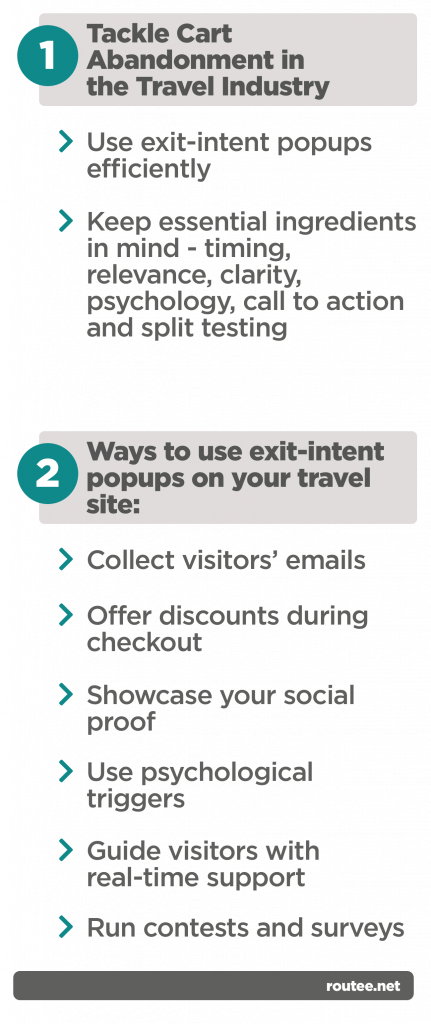
How can you reduce cart abandonment using exit popups in your travel business?
Abandoned shopping carts are a painful issue that many brands face in all industries and the travel business community cannot be exempt. According to the statistics from the travel industry, there is a 20% drop-off rate between basket and checkout, with less than 1% of users confirming their purchase. That adds up to nearly $1.78 trillion of incomplete annual travel purchases.
Similar to the eCommerce industry, the reasons visitors of travel sites do not easily convert are the following:
- Research for better deals and packages
- Getting distracted or saving packages for later
- Forgetting the brand name due to information overload
- Bad user experience leading to not understanding or finding what they are looking for
Why use exit-intent popups?
Popups prove to be an effective way to convert users. Exit-intent popups even more so. Reports say that 70% of users do not return to a site after they quit, however, exit-intent popups are capable of converting 10% of those users.
Exit-intent popups are triggered when the visitor is about to click the exit button or clicks it to quit the page. They act as a final effort to stop a user from leaving a website. Exit-intent popups can be especially effective when it comes to shopping cart recovery, as they can give your brand a second chance to get your visitors to follow through on their purchase. Besides, exit-intent popups can be used for various purposes, such as collecting email addresses for marketing communication.
What makes a good exit-intent popup?
Here are six essential ingredients you need to have in mind when creating exit-intent popups for your website.
- Timing – The right time between a user being engaged in your products and them leaving your website.
- Relevance – Content that is relevant to the user about to leave your site.
- Clarity – Clear, simple, and to the point messaging, to get them back to your website.
- Psychology – Psychological influencers that can drive action.
- Call to action – Tell your user what to do next.
- Split testing – Run A/B split tests to see what works.
Ways to use exit-intent popups on your travel site
Let us now discuss some exit-intent strategies to help boost shopping cart recovery in the travel industry.
Collect visitors’ emails
They came, they browsed and now they are on their way out. Do not just let them go. Collect their email while they are at the exit, with a popup. Instead of vaguely asking for their email, ask them to ‘Sign up to your deals and packages newsletter’. Now, even if they go ahead and abandon their shopping cart, they might be tempted not to abandon it forever. You can send them cart recovery emails, requesting them to recover and complete their booking.
Alternatively, you can capture their email by offering to save their cart so they can return anytime they want. A lot of travelers put stuff in their cart, although they are not planning to check out right away. They want to compare prices, think about the best combination of dates, and maybe come back to book their trip a bit later.
Besides, you can collect visitors' emails using exit-intent popups to boost your upselling by sending them coupons or offers on rental cars, once they complete a purchase. This way, not only do you drive repeated sales but you also boost your customer retention rate. Email is considered to be one of the most effective channels for tourism marketing.
Offer discounts during checkout
Most internet users interested in travel services look for good deals and travel packages. A discount can be particularly alluring to someone browsing your website.
One of the major reasons why travel site visitors abandon their carts is the desire to research for better deals and packages. When they reach the checkout and once all prices are added up, tax included, they suddenly begin to have second thoughts, as they are about to spend significantly more money than they initially expected. That is why displaying a well-timed discount popup at checkout, can entice them to go ahead and book their room, saving the sale. A large percentage of customers say that if they are offered a lower price, they will reconsider leaving and will purchase the products in their cart.

Showcase your social proof
Before they make a purchase, travel website visitors want to know that your travel site is legit. Traveler reviews and social proof are great tools to use to convince users to book from a platform that they have not previously purchased. A recent study concluded that visitors can be motivated to take a specific action if you display customer testimonials and social proof. Showcasing customer reviews on your exit-intent popups creates a sense of trust, which can prevent users from abandoning their carts.
Try using big numbers and impressive statistics in your exit-intent popups, related to your travel packages or traveler satisfaction, and encourage users to join that pack. You can even display positive reviews for users to take into consideration before deciding on what to do with their shopping cart.
If you maintain an impressive social following, you can also show that off. Website travel visitors, especially millennials, hang out on social media. When they see that your business has a distinctive social following they will want to join. Time your campaign so that you display your pop-up right before visitors exit. According to an AdWeek study, about 52% of Facebook users dream about vacation when on this social media channel, even when they are not planning a specific trip.
Use psychological triggers
Your ultimate goal when creating an exit-intent pop-up is to trigger a strong desire in a user to return to their shopping cart and complete the purchase. There are several psychological tactics you can use to make that happen, such as scarcity and urgency. Urgency is said to create the FOMO effect (Fear Of Missing Out) in users, a feeling that they are missing out on a travel opportunity that they might not get again. That is the reason why most exit-intent popups use phrases such as “Wait" or “Hold on" to create a sense of urgency, urging customers to take action.
A limited-time discount is a great way to create a sense of urgency for a hotel or trip booking. Around 48% of users said that they always complete a purchase when there is a limited-time offer they can relate to. Scarcity is a bit different from urgency. While urgency makes the person think they will miss out on an opportunity if they do not purchase a travel package immediately, scarcity makes a traveler think their preferred accommodation option could sell out at any moment, if they do not hurry up and purchase it. When creating scarcity, customers do not have the time to think, they must act quickly or they might miss out.
By creating a sense of urgency or scarcity in your exit-intent popup strategy, users feel that they better stay on the site and finish their reservation before the offer ends or their room is sold out.
Guide visitors with real-time support
A common reason users abandon their carts is because they cannot understand the details or options on a website. When users are not clear as to how to proceed to the next step they ultimately leave the website. Right before users are about to exit your page is the perfect time for you to start a conversation by displaying an exit-intent popup, where they can enter their queries.
Run contests and surveys
You can use contests and surveys in your exit-intent popup campaign to reduce your website’s bounce rates, increase engagement, and boost conversions on packages offered on your website. Your exit-intent popup campaign can target visitors that are about to leave your website with an interesting contest. Since the campaign is triggered after they have consumed a large amount of your existing content, they are likely to participate in the contest or the survey.
Additionally, you can create survey campaigns and communicate them with an exit-intent popup. These surveys will help you gain a better insight into your customers and what they want, including the reason they wish to exit your site.
Convert your visitors into travelers
Exit-intent popups are highly effective at capturing visitors who are leaving their shopping cart behind. You can use exit-intent popups to make your visitors reconsider buying your travel services and either head back to their booking cart, or enter their email address for you to use in your abandonment email campaigns. Let this be an opportunity for you to encourage travel enthusiasts back to your site to make their next dream trip a reality by using your services.
Check out how you can reduce shopping cart abandonment with personalization.
